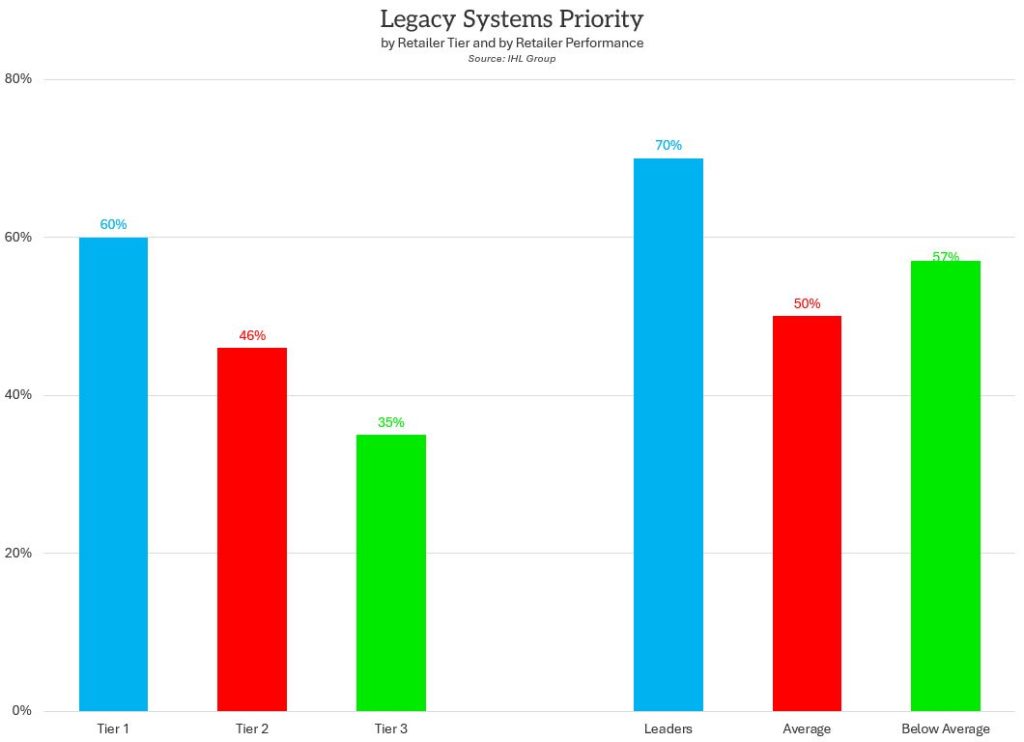Navigating Legacy Systems Challenges for Tier 1 Retailers
In the fast-paced world of retail, Tier 1 retailers (those with annual sales of $1 Billion or more, who drive IT spending in the industry) face a unique set of challenges, particularly when it comes to managing legacy systems. The prevalence of legacy systems can significantly impact operational efficiency, innovation, and customer experience. Here we will explore the specific pain points associated with legacy software for Tier 1 retailers. We will also explore strategies for effective management and IT modernization.
Understanding the Impact of Legacy Systems
Legacy systems pose a range of challenges for Tier 1 retailers. Among them are limitations in adapting to evolving technological landscapes and the integration of advanced retail solutions. Our recent study “Winning the Race of Innovation“, done with our partner RIS News, shows that Tier 1 retailers are increasingly focusing on innovation. Fully 50% of them highlight it as a priority. However, legacy systems (60%, see figure below) can hinder innovation efforts, making it difficult to adopt cutting-edge technology and AI-driven solutions.
Further, Tier 1 retailers emphasize the importance of integration across solutions (48% see it as a key support pain point). Legacy systems often struggle to seamlessly integrate with modern solutions, impacting overall operational efficiency and customer satisfaction.

Strategies for Effective Management and IT Modernization
To address these challenges, Tier 1 retailers need to consider proactive strategies for managing and modernizing legacy systems. This may involve investing in robust IT infrastructure, prioritizing network speed and reliability, and ensuring adequate staffing to support the IT needs of the organization. Fully 62% of Tier 1 retailers prioritize network speed and reliability. This underscores the critical role of a stable network infrastructure in overcoming legacy software limitations.
Moreover, IT modernization strategies, such as migration to cloud-based platforms and the recruitment of qualified personnel, are essential for mitigating the impact of legacy systems on retail operations.
Overcoming Barriers to Modernization
While the benefits of modernizing legacy systems are clear, Tier 1 retailers may face various barriers in this process. Integration across solutions is a top pain point for “Leaders” (retailers with 2023 sales growth > 10%). This emphasizes the need to overcome integration challenges associated with legacy systems. Additionally, the rate of IT spend growth and segment-related challenges can influence the modernization efforts of Tier 1 retailers. By understanding and addressing these barriers, retailers can effectively navigate the complexities of legacy systems modernization. This will pave the way for enhanced innovation and operational efficiency.
In closing, legacy systems challenges are a significant concern for Tier 1 retailers. They impact their ability to innovate and integrate advanced retail solutions. By prioritizing effective management and IT modernization strategies, such as investing in network infrastructure and overcoming integration barriers, retailers can position themselves for success in an increasingly competitive retail landscape. Addressing legacy systems challenges is not only a technological necessity but also a strategic imperative for Tier 1 retailers looking to drive innovation and deliver exceptional customer experiences. This blog post aims to provide valuable insights for Tier 1 retailers seeking to navigate the complexities of legacy software and embrace the opportunities presented by modern retail technology.